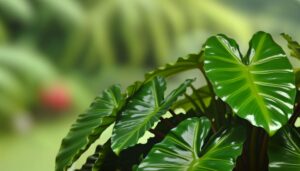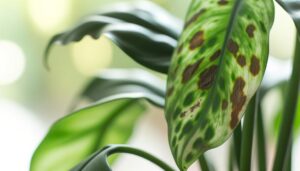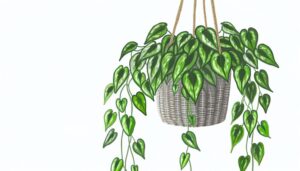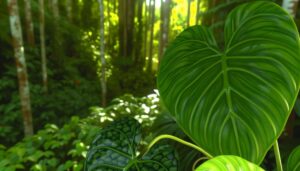What Is the Best Pot Size for a Philodendron Hope?
The best pot size for a Philodendron Hope should be approximately 2 inches larger in diameter than its current root mass. This guarantees sufficient space for the fibrous root system's lateral proliferation and high branching density.
The pot must feature multiple drainage holes to prevent waterlogging and root rot. Materials like terracotta promote aeration and reduce excessive moisture retention, essential for maintaining root health.
Repotting every 18-24 months, or when roots become pot-bound, ensures sustained plant vigor. Seasonal repotting is advantageous to align with the plant's growth cycle.
Consistent monitoring of root conditions and proper pot selection are pivotal. Further insights await on these factors.
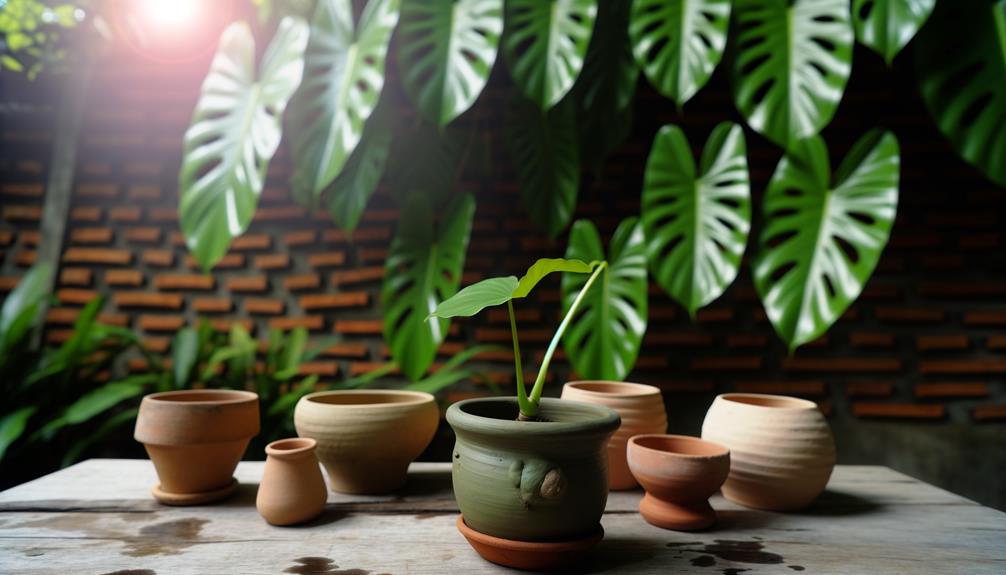
Key Takeaways
- Ensure the pot is 2 inches larger in diameter than the current root ball.
- Choose a pot with multiple drainage holes to prevent waterlogging.
- Select a material that balances moisture retention and aeration, like terracotta or ceramic.
- Repot every 18-24 months based on growth rate and root development.
- Use well-draining soil to prevent root rot and facilitate healthy growth.
Understanding Philodendron Hope
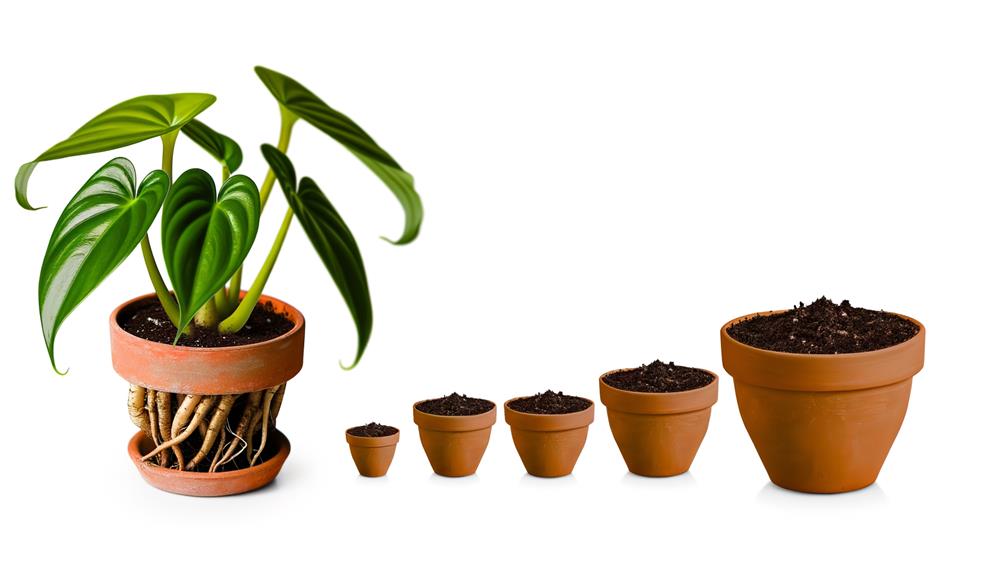
Philodendron Hope, scientifically classified as Philodendron bipinnatifidum, belongs to the Araceae family and is characterized by its large, deeply lobed leaves and robust growth habit.
This species exhibits a perennial growth cycle, thriving in tropical and subtropical climates. The leaves, which can extend up to three feet in length, are pinnatifid with a pronounced, leathery texture, facilitating efficient photosynthesis and transpiration.
The plant's indeterminate growth pattern results in continuous foliage expansion, necessitating careful attention to spatial requirements. It employs a sympodial growth habit, where each new shoot emerges from a point adjacent to the previous one.
This morphological trait significantly affects its spatial dynamics and overall structural integrity, making the selection of an appropriate container essential for best development.
Root System Basics
Philodendron Hope displays a fibrous root system characterized by extensive lateral root proliferation, which facilitates efficient nutrient and water absorption.
Monitoring root growth patterns is essential for determining best pot size, as constrained roots can impede plant development and vigor.
Root health indicators such as root color, turgidity, and the presence of root tips are critical metrics for evaluating overall plant well-being and ensuring proper growth conditions.
Root Growth Patterns
Understanding the root growth patterns of Philodendron Hope requires an examination of its fibrous root system, which is characterized by numerous thin, branching roots that efficiently absorb water and nutrients from the soil. This root structure allows for significant surface area contact, maximizing nutrient uptake and promoting vigorous growth. The following table illustrates key attributes of the Philodendron Hope's root system:
| Attribute | Description | Importance |
|---|---|---|
| Root Type | Fibrous | Enhances water and nutrient absorption |
| Root Depth | Shallow to Moderate | Requires careful pot size selection |
| Branching Density | High | Ensures extensive soil contact |
| Growth Rate | Moderate to Fast | Influences repotting frequency |
| Root Sensitivity | Low to Moderate | Tolerates some disturbance during repotting |
This understanding is essential for selecting an appropriate pot size, ensuring ideal growth conditions for Philodendron Hope.
Root Health Indicators
Evaluating the health of a Philodendron Hope's root system entails examining several key indicators. Healthy roots typically exhibit a creamy white or light tan color, indicating active nutrient uptake and robust cellular structure. Firmness is equally crucial; turgid roots suggest optimal hydration and structural integrity.
Conversely, mushy or discolored roots, often brown or black, may signify root rot or fungal infections, necessitating immediate intervention. Additionally, inspecting for lesions, mold, or an off-putting odor can help identify pathogenic afflictions.
Regular monitoring of these root health indicators ensures early detection of potential issues, facilitating timely corrective measures and promoting overall plant well-being in Philodendron Hope.
Ideal Pot Dimensions
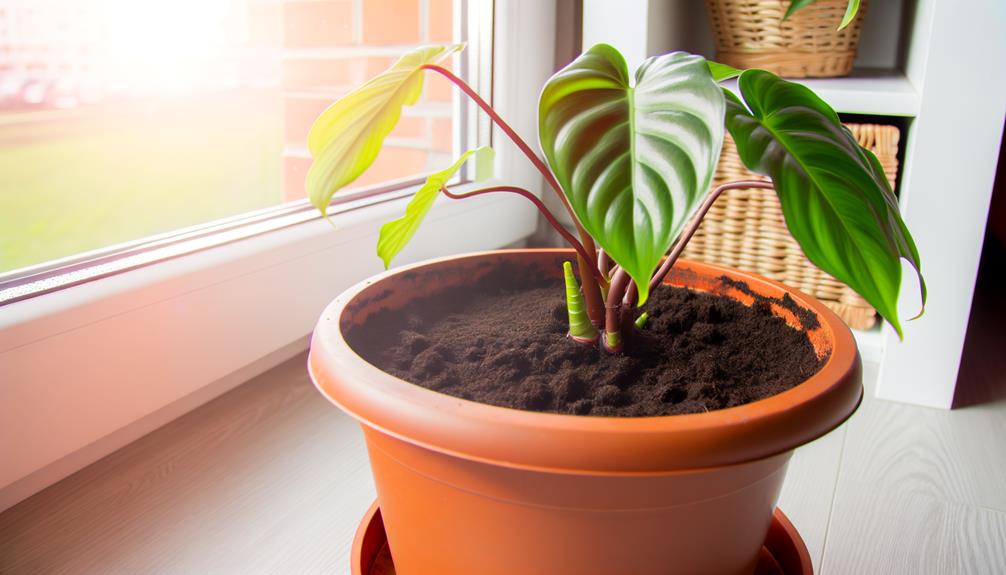
Selecting the best pot dimensions for Philodendron Hope is essential for promoting healthy root growth and ensuring adequate space for expansion.
The inclusion of drainage holes is necessary to prevent waterlogging and root rot, thereby maintaining ideal soil aeration.
Additionally, the choice of pot material, whether plastic, terracotta, or ceramic, can influence moisture retention and overall plant health.
Root Growth Space
The finest pot dimensions for a Philodendron Hope typically allow for a root growth space that is approximately 2 inches larger in diameter than the current root ball, ensuring adequate room for root expansion and aeration.
This incremental increase in pot size supports optimal root development, preventing issues like root-bound conditions and promoting robust plant health. A pot that is too large can result in water retention and root rot, while one that is too small can limit nutrient uptake and hinder growth.
The ideal pot should also accommodate the plant's natural growth habits, providing sufficient depth for the root system to establish itself securely. This balance fosters a thriving environment for the Philodendron Hope's root architecture.
Drainage Hole Importance
Proper drainage is critical for Philodendron Hope, as it prevents waterlogging and guarantees sufficient oxygenation of the root system. The ideal pot must have drainage holes to facilitate the removal of excess water, thereby reducing the risk of root rot and promoting healthy root development.
To ensure optimal growth, consider the following critical factors:
- Hole Size: Guarantee drainage holes are large enough to allow water to escape but not so large that they allow soil to wash out.
- Hole Quantity: Multiple drainage holes improve overall drainage efficiency.
- Pot Shape: A pot with a broader base can provide better stability and evenly distributed drainage.
- Watering Practices: Regularly monitor soil moisture to prevent overwatering, even with adequate drainage.
Understanding these factors is crucial for thriving Philodendron Hope plants.
Material Considerations
When determining the best pot dimensions for Philodendron Hope, the choice of material can greatly impact the plant's overall health and growth. Porous materials like terracotta allow for excellent aeration and moisture regulation, reducing the risk of root rot.
Conversely, non-porous materials such as plastic or glazed ceramic can retain moisture longer, which may require a more careful watering schedule.
The best pot should have a diameter of 1-2 inches larger than the plant's root ball, allowing space for growth without causing waterlogging. Depth is equally crucial; a pot depth of 10-12 inches ensures sufficient root expansion and stability.
These considerations, combined with appropriate potting mix and drainage, create an optimum environment for Philodendron Hope.
Growth Rate and Pot Size
Understanding the correlation between growth rate and pot size is crucial for optimizing the health and development of Philodendron Hope. Adequate root space directly influences the plant's physiological processes, including nutrient uptake and water retention. A pot that is too small restricts root expansion, leading to stunted growth and potential root-bound conditions.
Conversely, an excessively large pot can result in overwatering, which promotes root rot due to poor aeration. Consider the following key points:
- Root Confinement: Small pots inhibit root growth, limiting nutrient absorption.
- Overwatering Risk: Large pots increase the risk of waterlogging and root rot.
- Optimal Pot Size: A pot that allows 1-2 inches of space around the root ball promotes healthy growth.
- Repotting Frequency: Regular assessment and repotting every 1-2 years guarantee sustainable growth.
Material Matters
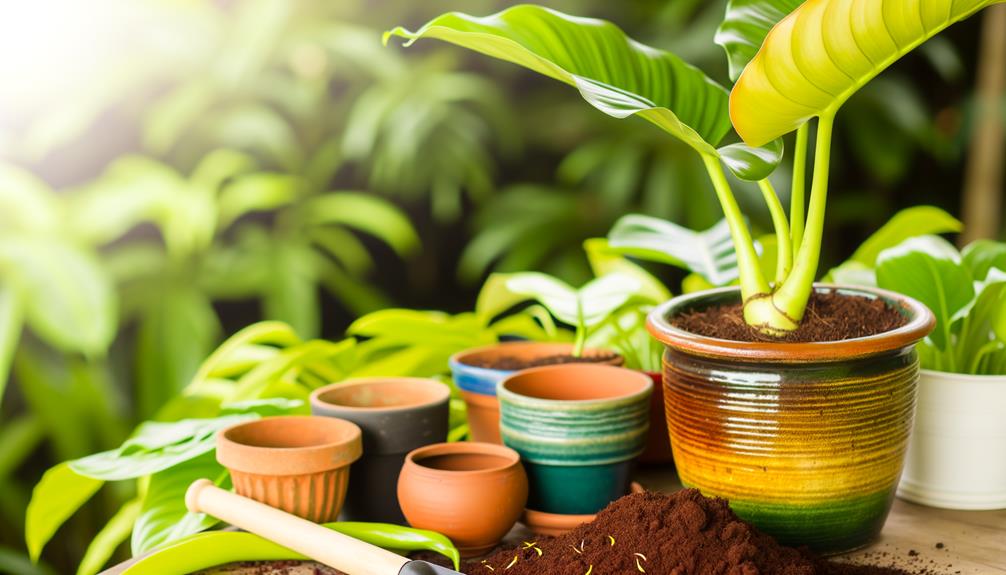
Selecting the suitable pot material is essential to maintaining ideal moisture levels and ensuring proper root aeration for Philodendron Hope. Pot materials such as terracotta, plastic, and ceramic each offer distinct advantages.
Terracotta pots, made of porous clay, permit air exchange and facilitate moisture regulation, helping to reduce risks of root rot. However, they require more frequent watering.
In contrast, plastic pots retain moisture longer due to their non-porous nature, decreasing the need for frequent watering but potentially increasing the risk of overwatering.
Ceramic pots, frequently glazed, strike a balance by providing aesthetic appeal and moderate moisture retention. Understanding the properties of the material allows horticulturists to optimize the growing conditions, promoting robust growth and minimizing potential physiological stressors.
Drainage Importance
Drainage is a critical factor in the health of Philodendron Hope, primarily to prevent root rot and guarantee the plant's longevity.
Adequate drainage facilitates proper aeration, allowing oxygen to reach the root system and preventing waterlogged conditions that can lead to pathogenic fungal infections.
As a result, selecting a pot with sufficient drainage holes and using well-draining soil are essential practices for the best plant care.
Preventing Root Rot
Facilitating adequate drainage is crucial to preventing root rot in Philodendron Hope, as it permits excess water to escape, thereby maintaining optimal soil aeration and preventing anaerobic conditions that support pathogenic fungal growth. This process is vital to plant health, and executing it effectively requires careful consideration of several factors:
- Pot Selection: Choose containers with multiple drainage holes to promote water escape.
- Soil Composition: Utilize well-draining soil mixtures, incorporating perlite or coarse sand for improved drainage.
- Watering Practices: Implement a routine that allows soil to partially dry between waterings.
- Elevation: Raise pots using saucers or stands to guarantee unimpeded drainage and airflow.
Ensuring Proper Aeration
Proper aeration is vital for the root health of Philodendron Hope, as it facilitates the exchange of gases and prevents the accumulation of excess moisture that can lead to root rot. The presence of oxygen in the root zone is crucial for cellular respiration, enabling roots to absorb nutrients efficiently.
Utilizing a pot with ample drainage holes is necessary to guarantee water percolates through the soil matrix, thereby averting anaerobic conditions. Employing a well-aerated potting mix, consisting of components such as perlite, pine bark, and coarse sand, further enhances drainage and oxygen availability.
Additionally, the use of a pot with a slightly larger diameter than the root ball allows for sufficient air circulation, promoting robust root development and overall plant vigor.
Repotting Frequency
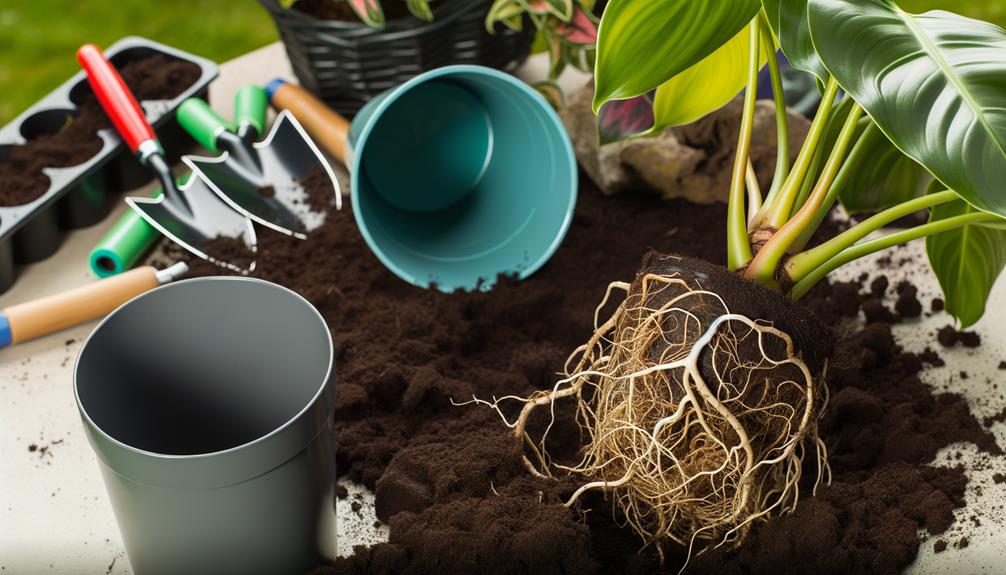
Repotting frequency for a Philodendron Hope is typically dictated by the plant's growth rate and root development, necessitating a thorough understanding of its physiological needs and environmental conditions. Typically, repotting is recommended every 18-24 months.
Key factors influencing this timeline include:
- Root Bound Condition: When roots encircle the pot, this restricts nutrient uptake, necessitating a larger container.
- Soil Degradation: Over time, soil loses its structure and nutrient content, impacting plant health.
- Visible Root Growth: Roots emerging from the drainage holes signal that the plant has outgrown its current pot.
- Plant Size Increase: Significant growth in foliage often requires more root space, prompting a need for repotting.
This structured approach ensures peak growth and health for your Philodendron Hope.
Signs of Under-Potting
Often, signs of under-potting in a Philodendron Hope manifest through stunted growth and restricted root expansion due to insufficient space within the container.
The limited root zone impedes nutrient uptake and water absorption, leading to chlorosis and leaf necrosis. An under-potted Philodendron Hope may exhibit symptoms such as smaller-than-average leaves, weak stems, and a general loss of vigor.
Root-bound conditions, characterized by roots circling along the pot's perimeter, further exacerbate these issues, causing diminished overall plant health. Additionally, the lack of room for root elongation can lead to poor aeration and drainage within the substrate, resulting in anoxic conditions detrimental to root function.
Recognizing these indicators is vital for timely intervention and repotting to ensure best growth conditions.
Signs of Over-Potting
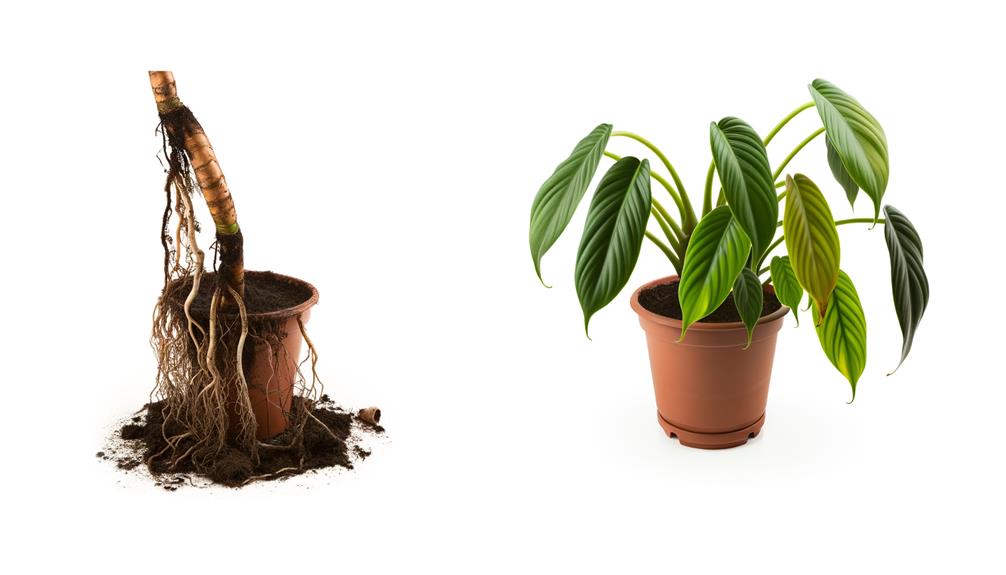
Over-potting a Philodendron Hope can lead to excessive water retention in the soil, resulting in root rot and other pathogenic infections due to anaerobic conditions. Recognizing the signs of over-potting is essential for maintaining plant health.
These signs include:
- Yellowing Leaves: Excess moisture can cause chlorosis, leading to yellowing foliage.
- Root Rot: A waterlogged environment promotes fungal growth, resulting in decayed roots.
- Wilting Despite Moist Soil: Paradoxically, the plant may wilt due to impaired root function.
- Foul Smell from Soil: Anaerobic bacteria thrive in overly moist conditions, producing a malodorous scent.
Seasonal Considerations
Understanding the seasonal growth patterns of Philodendron Hope is essential for optimizing repotting schedules and ensuring robust plant health. This tropical species exhibits pronounced growth during warmer months, necessitating specific care adjustments. Spring and summer are ideal for repotting due to accelerated root development and foliar expansion. Conversely, autumn and winter signal dormancy, reducing the plant's metabolic demands and making repotting less effective.
| Season | Growth Activity |
|---|---|
| Spring | High root and leaf growth |
| Summer | Continued vigorous growth |
| Autumn | Slowed growth, prepare for dormancy |
| Winter | Dormant, minimal growth |
Conclusion
To determine the best pot size for Philodendron Hope, one must consider its root system, growth rate, and material preferences.
A pot with a diameter of 12-14 inches usually offers sufficient space for the plant's extensive root network.
The choice of pot material also plays a role in root health, with terracotta providing excellent aeration.
Identifying signs such as stunted growth or root-bound conditions, similar to a warning signal, helps in promptly repotting to promote robust plant growth.

